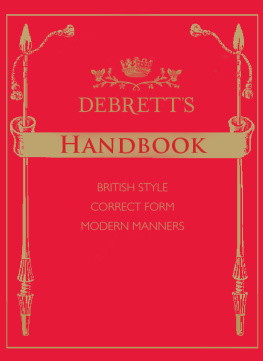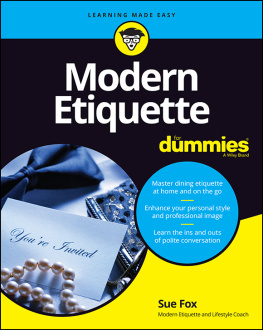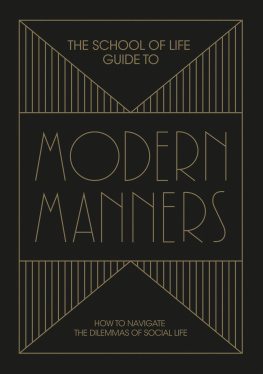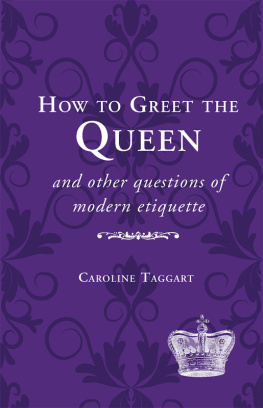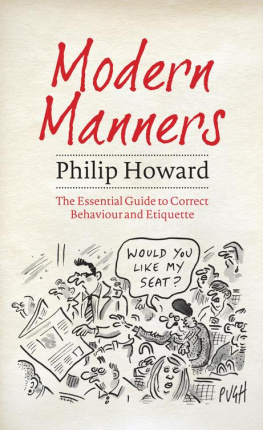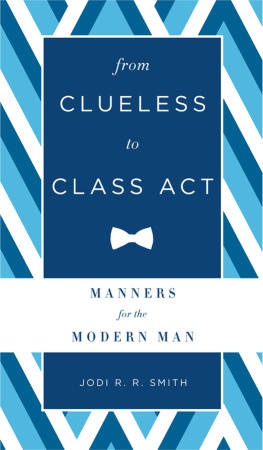

D EBRETT S C ORRECT F ORM WAS FIRST PUBLISHED IN 1970 AS an invaluable guide to forms of address after the upheavals of the 1960s, when institutions such as local government, the armed forces, the judiciary and the Church had been subjected to a great deal of change.
Regularly revised and updated, Debretts Correct Form has never been out of print, and has now been amalgamated into this new publication, the Debretts Handbook. Debretts authoritative advice covers addressing the Royal Family, titles, Crown honours, precedence and protocol, as well as professional forms of address. Effective communication is the cornerstone of good manners and formal correspondence is an area where traditional rules still have their place. Debretts Handbook contains a comprehensive guide to correspondence, from the most formal to business and social, including use of email and social media, undreamt of in 1970.
As well as encompassing Correct Form, the new Debretts Handbook is also an extensive guide to contemporary manners, the first time that Debretts has combined these two complementary elements. It examines traditions and behaviour in a range of contexts and widely-encountered situations, from very formal events and major rites of passage, such as christenings, weddings and funerals, to home entertaining and hosting informal gatherings. It also offers a modern interpretation of the foundations that underpin all manners: introductions, small talk, conversation, compliments. It will help the reader to feel at ease, and put others at ease, in every situation.
W E LIVE IN A COSMOPOLITAN AND EGALITARIAN AGE AND customs and manners are increasingly less prescriptive. Yet this fluidity can present a challenge, as politeness and consideration, which should underpin social behaviour and etiquette, may get lost. Ironically, the more relaxed society becomes, the more useful it is to have the knowledge to navigate its nuances.
Etiquette is about understanding and mastering a set of clear and pragmatic guidelines that have evolved to make everyone feel welcome and valued. Manners make everyday life easier, removing anxiety and minimising social difficulties or awkwardness. Politeness, therefore, does not intimidate or create barriers: instead it should make communication clearer. Etiquette must adapt and shift with time, especially as we become increasingly absorbed in our own digital bubble (screens, keyboards, headphones), which may erode the ability to observe, and interact with, those around us.
In a highly competitive age, manners are still valued and noticed by many, and the confidence associated with mastering social skills is an essential tool. Good manners are attractive and empowering, showing not weakness but strength. Employers bemoan the awkwardness of job candidates; educationalists are arguing that manners have their place on the national curriculum. It is proven that the confidence manners provide can set individuals apart and give them a competitive edge.
The essence of good manners is to treat other people as you would wish to be treated yourself, to show empathy, so that no one feels confused, excluded or exposed. Debretts believes that good manners do not advertise themselves in opaque rituals and exaggerated behaviour. When used with integrity, they are the unobtrusive gestures that make the world a more civilised and agreeable place.
Sir Jeremy Stuart-Smith;
Alistair Harrison, Marshal of the Diplomatic Corps;
Jonathan Spencer, Assistant Comptroller Lord Chamberlains Office;
Patric Dickinson, Clarenceux King of Arms;
Mrs Sophie Reilly, Court of the Lord Lyon;
Ross Gillson, Secretary to the House of Bishops
Communicating with The Queen |
Invitations to Members of the Royal Family |
Private Secretaries to the Royal Family |
Entertaining Royal Guests |
Invitations from the Royal Family |
The Peerage |
Duke |
Marquess |
Earl |
Viscount |
Baron |
Courtesy Titles |
The Scottish Title of Master |
Life Peers |
Disclaimed Peerages |
Baronets |
Knights |
Dames |
Scottish Titles |
Irish Hereditary Knights |
Privy Counsellors |
Untitled Persons |
The University Hierarchy |
Principal Titles |
Letters Denoting Degrees |
Academic Forms of Address |
The Royal Navy |
The Army |
The Royal Air Force |
Forms of Address |
Lord-Lieutenants |
High Sheriffs |
Local Order of Precedence |
Lord Mayors, Mayors & Civic Heads |
Forms of Address |
Forms of Address |
The Judiciary: England & Wales |
Forms of Address |
The Judiciary: Scotland |
The Church of England |
Archbishops |
Bishops |
Other Members of Clergy |
Church of Scotland |
Methodist Church |
Chaplains |
Roman Catholic Church |
Non-Christian Faiths |
Forms of Address |
Medical Qualifications |
Fellowships & Memberships |
Forms of Address |
Commonwealth Titles |
Crown Honours |
Commonwealth Orders |
Appointments |
Academia & Religion |
Societies & Professions |
Sending out Invitations |
Replies |
Place cards |
Seating
Precedence |
Official Lists |
Grace |
Toasts |
Speeches |
Arrival |
Procedure |
Departure |
Etiquette |
Entertaining Members of the Royal Family |
White Tie |
Black Tie |
Morning Dress |
Highland Dress |
Lounge Suits |
Smart Casual |
Country Clothing |
Announcements |
After the Birth |
Religious Rituals |
Godparents |
Invitations |
Naming Rituals |
Confirmation |
Bar and Bat Mitzvahs |
18ths and 21sts |
Engagement Rings |
Practicalities |
Formal Announcements |
Celebrations |
The Guest List |
Next page
